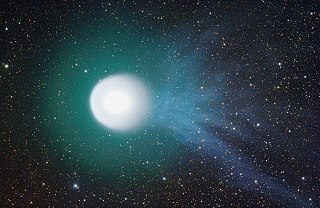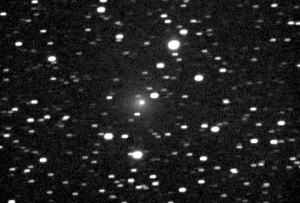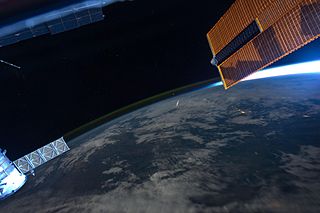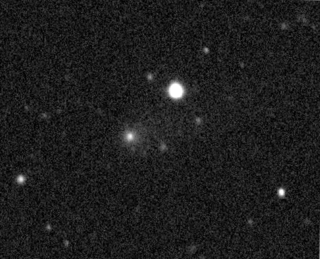Related Research Articles

12P/Pons–Brooks is a periodic comet with an orbital period of 71 years. It fits the classical definition of a Halley-type comet with an orbital period between 20 and 200 years, and is also one of the brightest known periodic comets, reaching an absolute visual magnitude ~5 in its approach to perihelion. Comet Pons-Brooks was discovered at Marseilles Observatory in July 1812 by Jean-Louis Pons, and then later recovered in 1883 by William Robert Brooks.

Tempel 1 is a periodic Jupiter-family comet discovered by Wilhelm Tempel in 1867. It completes an orbit of the Sun every 5.6 years. Tempel 1 was the target of the Deep Impact space mission, which photographed a deliberate high-speed impact upon the comet in 2005. It was re-visited by the Stardust spacecraft on February 14, 2011, and came back to perihelion in August 2016. On 26 May 2024, it will make a modest approach of 0.55 AU to Jupiter which will lift the perihelion distance and 9P will next come to perihelion on 12 February 2028 when it will be 1.77 AU from the Sun.
39P/Oterma is a currently inactive periodic comet with an orbital period of nearly 20 years that stays outside the orbit of Jupiter. The nucleus has a diameter around 4–5 km. It was last observed in August 2021 and came to perihelion in July 2023 while 1.2 AU from Jupiter. It will finish the modest approach to Jupiter in January 2025 and will next come to perihelion in July 2042 at distance of 5.9 AU from the Sun. Opposition has occurred on 11 November 2023.

52P/Harrington–Abell is a periodic comet in the Solar System.

53P/Van Biesbroeck is a periodic comet 7 km in diameter. Its current orbital period is 12.53 years.

77P/Longmore is a periodic comet in the Solar System, with a period of 6.8 years.

Comet Finlay is a periodic comet with an orbital period of 6 years discovered by William Henry Finlay on September 26, 1886. The next perihelion passage is July 13, 2021 when the comet will have a solar elongation of 54 degrees at approximately apparent magnitude 10. It last came to perihelion on December 27, 2014, at around magnitude 10. Of the numbered periodic comets, the orbit of 15P/Finlay has one of the smallest minimum orbit intersection distances with the orbit of Earth (E-MOID). In October 2060 the comet will pass about 5 million km from Earth.

Comet Holmes is a periodic comet in the Solar System, discovered by the British amateur astronomer Edwin Holmes on November 6, 1892. Although normally a very faint object, Holmes became notable during its October 2007 return when it temporarily brightened by a factor of a million, in what was the largest known outburst by a comet, and became visible to the naked eye. It also briefly became the largest object in the Solar System, as its coma expanded to a diameter greater than that of the Sun. Between 1857–2106 perihelion remains between 2.05–2.36 AU.

Comet Kopff or 22P/Kopff is a periodic comet in the Solar System. Discovered on August 23, 1906, it was named after August Kopff who discovered the comet. The comet was missed on its November 1912 return, but was recovered on its June 1919 return and has been seen at every apparition since. Close approaches to Jupiter in 1938 and 1943 decreased the perihelion distance and orbital period. 22P/Kopff’s last perihelion passage was 18 March 2022. On 13 July 2028 it will pass 0.353 AU (52.8 million km) from Earth.

Comet Schaumasse is a periodic comet discovered by Alexandre Schaumasse on 1 December 1911 as 12th magnitude. It next comes to perihelion on 8 January 2026 and should brighten to about magnitude 9.

54P/de Vico–Swift–NEAT is a periodic comet in the Solar System first discovered by Father Francesco de Vico on August 23, 1844. It has become a lost comet several times after its discovery. The comet makes many close approaches to Jupiter. The comet was last observed on 20 December 2009 by Ageo Observatory.
Comet 30P/Reinmuth, also known as Comet Reinmuth 1, is a periodic comet in the Solar System, first discovered by Karl Reinmuth on February 22, 1928.

144P/Kushida is a periodic comet discovered in January, 1994, by Yoshio Kushida at the Yatsugatake South Base Observatory in Japan. This was the first comet discovery of 1994 and his second discovery within a month. It next comes to perihelion on 25 January 2024 and should brighten to about magnitude 9.
122P/de Vico is a periodic comet with an orbital period of 74 years. It fits the classical definition of a Halley-type comet with. It was discovered by Francesco de Vico in Rome on February 20, 1846.
82P/Gehrels is a periodic comet that was discovered on October 27, 1975, by Tom Gehrels at the Palomar Mountain Observatory in California having a faint nuclear brightness of magnitude 17.

Comet Swift–Tuttle is a large periodic comet with a 1995 (osculating) orbital period of 133 years that is in a 1:11 orbital resonance with Jupiter. It fits the classical definition of a Halley-type comet, which has an orbital period between 20 and 200 years. The comet was independently discovered by Lewis Swift on July 16, 1862 and by Horace Parnell Tuttle on July 19, 1862.

44P/Reinmuth or Reinmuth 2 is a Jupiter-family comet that is greatly perturbed by the gas giant Jupiter. The diameter of this comet is estimated at 3.22 km and its absolute magnitude at 11.

70P/Kojima is a periodic comet in the Solar System with a current orbital period of 7.05 years.

Comet 252P/LINEAR is a periodic comet and near-Earth object discovered by the LINEAR survey on April 7, 2000. The comet is a Jupiter family comet, meaning that it passes quite close to the orbit of Jupiter.

210P/Christensen is a Jupiter family periodic comet with an orbital period of 5.7 years. It was discovered by Eric J. Christensen on 26 May 2003 in images taken by the Catalina Sky Survey and recovered in images obtained by STEREO, the first time a single-apparition comet was recovered by a spacecraft.
References
- 1 2 3 4 "JPL Small-Body Database Browser: 33P/Daniel". Jet Propulsion Laboratory . Retrieved 2010-02-26.
2009-04-24 last obs
- ↑ MPC
- 1 2 Kinoshita, Kazuo (2018-07-18). "33P/Daniel past, present and future orbital elements". Comet Orbit. Archived from the original on 2011-07-10. Retrieved 2023-07-29.
- ↑ "BAA Comet Section : Periodic Comets". Jonathan Shanklin. 2011-12-18. Retrieved 2012-10-26.

